82 Types of Purple Flowers with Names and Pictures
Purple flowers bring more than just color—they evoke a sense of elegance, mystery, and artistic charm in any garden setting. If you’re drawn to the rich and dreamy hues of violet, lavender, or plum, this collection of purple blooms is made for you. From classic garden staples to unique showstoppers, we’ve gathered some of the most enchanting types of purple flowers to inspire your planting plans.
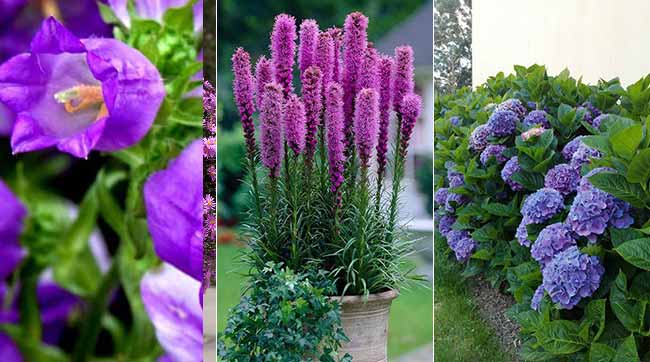
While some blossoms lean more toward lilac, indigo, or bluish tones, their overall presence still radiates the regal beauty purple is known for. Whether you’re designing a vibrant flowerbed or a serene corner of calm, these floral choices will make your garden bloom with personality and grace.
1. Hydrangea
Botanical Name: Hydrangea macrophylla
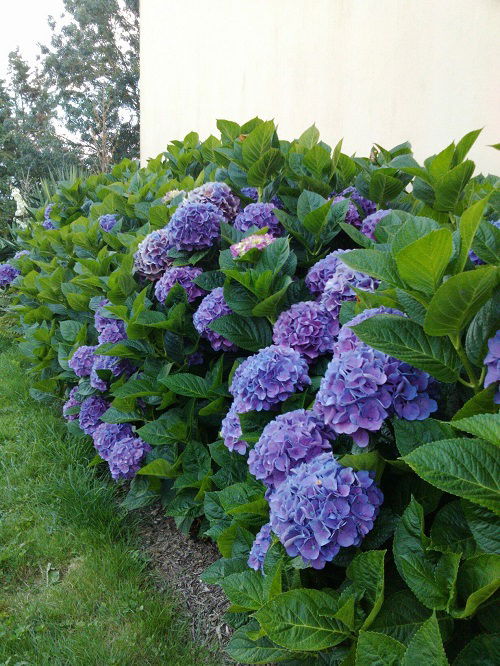
Hydrangeas are famous for their ability to change color based on soil pH — acidic soils produce stunning purples and blues. With large, globe-shaped flower clusters and lush green foliage, these shrubs offer long-lasting summer color and work wonderfully as hedges or foundation plantings.
________________________________________
2. Chinese Wisteria
Botanical Name: Wisteria sinensis
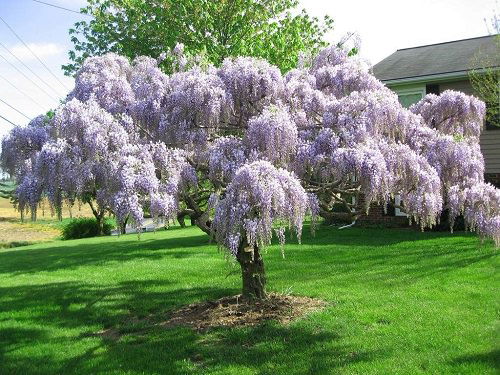
Chinese Wisteria creates a dramatic statement with its cascading clusters of fragrant purple flowers. Blooming in late spring, it covers pergolas, trellises, and arbors with ease. While breathtaking, it’s a vigorous grower and should be pruned regularly to keep it under control and prevent it from overpowering nearby structures or plants.
3. Sea Holly
Botanical Name: Eryngium
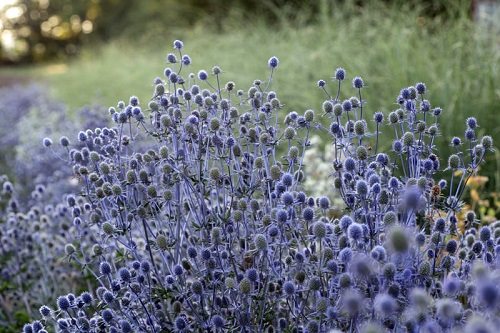
Sea Holly offers a bold architectural form with its spiky, metallic foliage and cone-shaped purple flower heads surrounded by sharp bracts. Drought-tolerant and deer-resistant, this perennial is an excellent choice for dry, sunny borders or coastal gardens. Its thistle-like appearance adds texture and contrast to flower arrangements and mixed plantings.
________________________________________
4. Verbena Botanical Name: Verbena
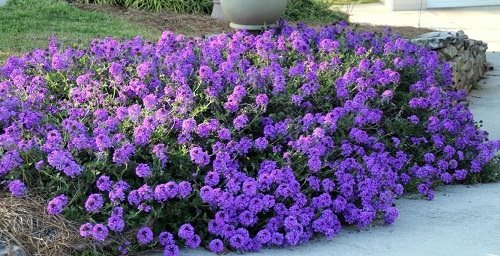
With their long, slender stems topped by clusters of small, vibrant purple flowers, verbenas are a favorite in both ornamental gardens and wildflower meadows. They attract pollinators like bees and butterflies and thrive in full sun, making them an excellent choice for adding vertical interest to garden beds or borders. They’re also drought-tolerant, which makes them suitable for xeriscaping and low-maintenance landscapes.
________________________________________
5. Butterfly Bush
Botanical Name: Buddleja
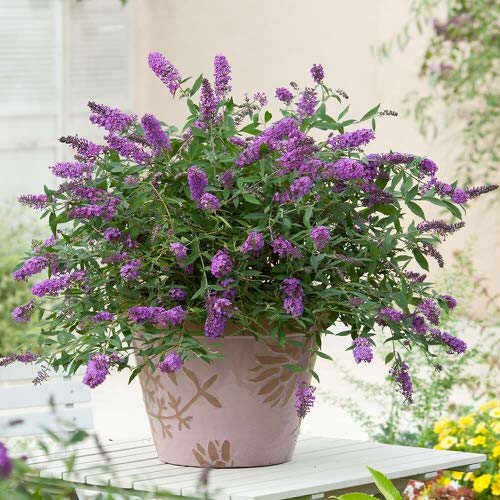
True to its name, the Butterfly Bush produces elongated panicles of nectar-rich, tubular purple flowers that are a magnet for butterflies and hummingbirds. These fast-growing shrubs can be pruned to control size and bloom profusely from mid-summer to early autumn. Their lush foliage and rich blossoms make them a stunning addition to any wildlife-friendly garden.
________________________________________
6. Gloxinia
Botanical Name: Sinningia speciosa
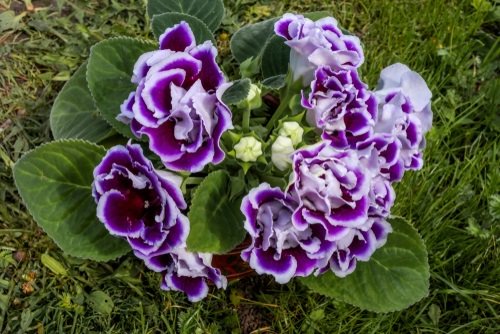
Gloxinia displays magnificent, velvety trumpet-shaped flowers in shades of deep purple and violet. These tender perennials are ideal for indoor gardening or shaded patios and bloom best when provided with indirect light and high humidity. Though they are grown as annuals in cooler climates, gloxinias can re-bloom when properly cared for.
________________________________________
7. Sweet Pea
Botanical Name: Lathyrus odoratus
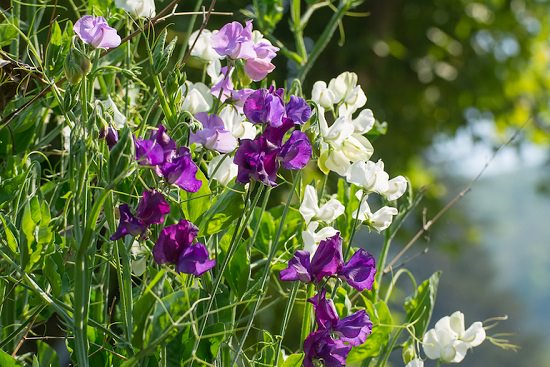
The charming, sweetly scented blossoms of the sweet pea come in a palette of pastels, with purple being a standout favorite. These climbing annuals are perfect for trellises, fences, or garden arches. Not only are they easy to grow, but their blossoms also make for delightful cut flowers that continue to perfume the air even after being brought indoors.
________________________________________
8. Hellebore
Botanical Name: Helleborus

Known as the “Christmas Rose” or “Lenten Rose,” hellebores are prized for their winter-to-spring blooms that defy cold weather. The purple varieties stand out with their subtle hues ranging from dusky plum to deep mauve. These perennials thrive in partial to full shade and are perfect for woodland gardens or shaded borders.
________________________________________
9. Purple Hibiscus
Botanical Name: Hibiscus
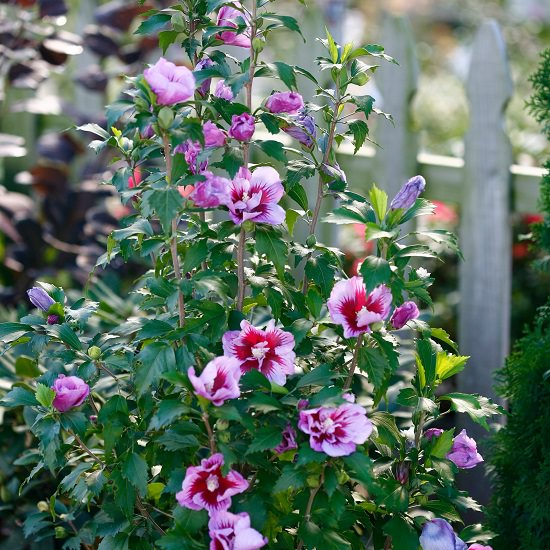
Both the hardy ‘Rose of Sharon’ and tropical hibiscus species feature cultivars with dramatic purple blooms. These large, showy flowers can be up to six inches wide, adding a bold splash of color to summer landscapes. Purple hibiscus loves warmth and sun, and it also works beautifully as a flowering hedge or container specimen.
________________________________________
10. Calla Lily
Botanical Name: Zantedeschia

Calla lilies, despite their name, are not true lilies. Native to southern Africa, they produce sleek, elegant flowers that resemble sculpted funnels, with purple cultivars ranging from soft lavender to deep plum. These striking plants thrive in moist, well-drained soils and make eye-catching additions to both garden beds and floral arrangements.
________________________________________
11. Zinnia
Botanical Name: Zinnia
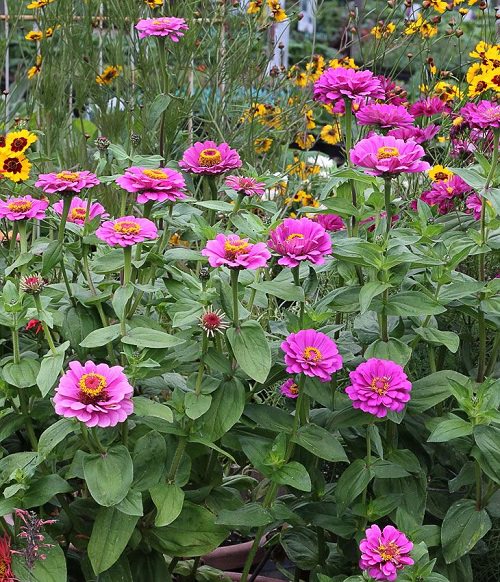
Zinnias are known for their bold and cheerful blooms in a wide array of colors, including rich purples and magentas. These sun-loving annuals are easy to grow from seed and bloom prolifically throughout the summer. They’re a favorite for pollinator gardens and bring a sense of joy to any space with their daisy-like structure and long-lasting blossoms.
________________________________________
12. Pincushion Flower
Botanical Name: Scabiosa
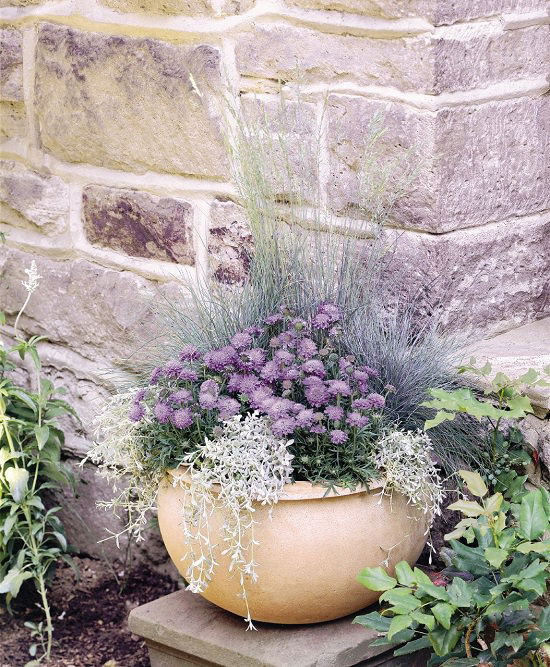
Named for its resemblance to a pincushion, this charming bloom has a domed center surrounded by delicate petals in shades of purple, blue, and lavender. With their long, wiry stems, pincushion flowers seem to float in the breeze. They’re low-maintenance, attract butterflies, and make long-lasting cut flowers.
________________________________________
13. Rhododendron
Botanical Name: Rhododendron

These broad-leaved evergreens produce large trusses of bell-shaped flowers in late spring, often in vibrant purple hues. Rhododendrons prefer acidic, well-draining soil and dappled shade. They pair beautifully with azaleas and make excellent feature plants or flowering hedges in woodland-style gardens.
________________________________________
14. Petunia
Botanical Name: Petunia

Available in an astonishing range of colors, petunias are beloved for their ease of care and continuous blooming. Purple petunias, with shades from soft lilac to deep violet, are especially striking in hanging baskets, containers, and borders. Deadheading spent blooms ensures a steady display throughout the growing season.
________________________________________
15. Pasque Flower
Botanical Name: Pulsatilla

One of the first flowers to bloom in early spring, the Pasque Flower has velvety, bell-shaped blossoms in shades of purple, rising above silvery, finely divided foliage. The entire plant is covered in soft hairs, giving it a fuzzy appearance. It’s well-suited to rock gardens and thrives in full sun and well-drained soil.
________________________________________
16. Pansy
Botanical Name: Viola tricolor
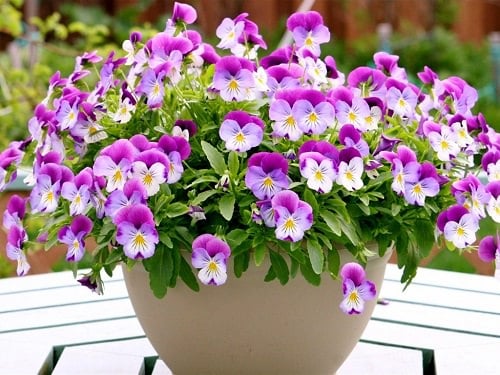
Pansies are cold-tolerant annuals or biennials with cheerful, five-petaled flowers in a wide array of colors, often with a characteristic “face.” Purple varieties are particularly eye-catching, ranging from pale violet to rich indigo. They’re ideal for window boxes, pots, and bedding displays, and bloom reliably from early spring through fall.
________________________________________
17. Fuchsia
Botanical Name: Fuchsia
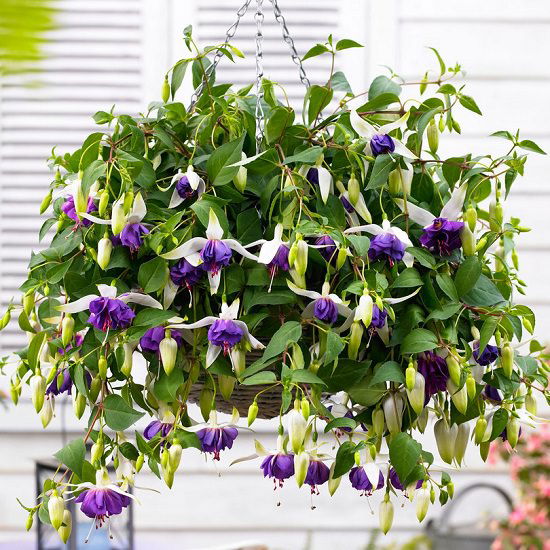
These pendulous flowers, often bicolored with shades of purple and pink, dangle like little ballerinas from arching stems. Fuchsias thrive in cool, shaded spots and are perfect for hanging baskets and patio planters. Their exotic appearance and nectar-rich blooms attract hummingbirds and bring movement to the garden.
________________________________________
18. Morning Glory
Botanical Name: Ipomoea
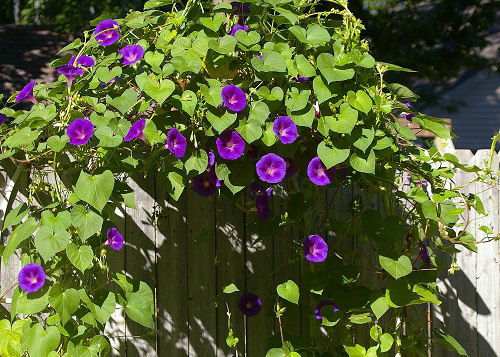
A fast-growing climber, morning glory covers trellises and fences with lush green leaves and vibrant, trumpet-shaped flowers that open with the morning sun. Purple cultivars such as ‘Grandpa Ott’ are especially striking. This annual vine reseeds readily and is perfect for creating quick summer coverage.
________________________________________
19. Aster
Botanical Name: Aster
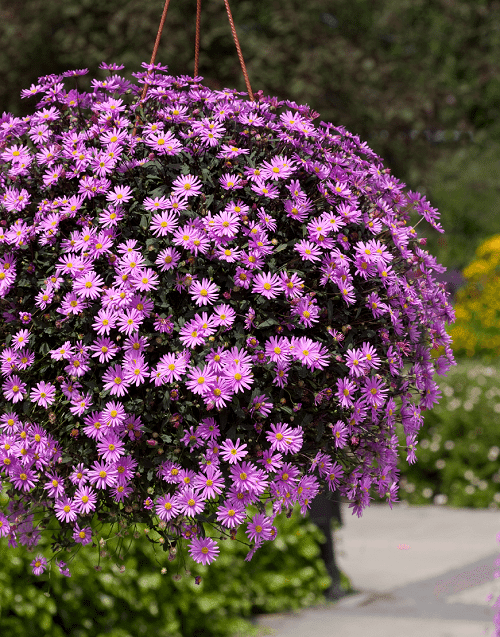
Asters bloom in late summer and fall, bringing much-needed color when most other flowers fade. Their daisy-like blooms in purple, lavender, and violet shades attract bees, butterflies, and other beneficial insects. Compact varieties are ideal for borders, while taller types work well at the back of flower beds.
________________________________________
20. Prairie Gentian (Lisianthus)
Botanical Name: Eustoma
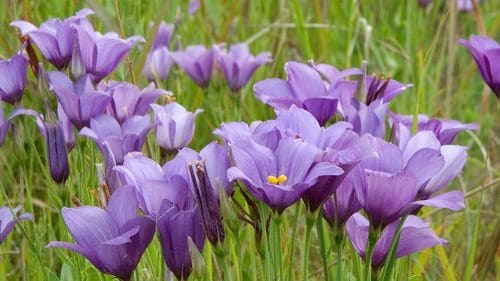
Often mistaken for roses, Lisianthus produces elegant, ruffled blooms in an array of colors, with deep purple being especially stunning. These long-lasting flowers are favorites for bouquets and can be grown in containers or sunny garden beds. Despite their delicate look, they’re surprisingly heat-tolerant.
21. Lupine
Botanical Name: Lupinus
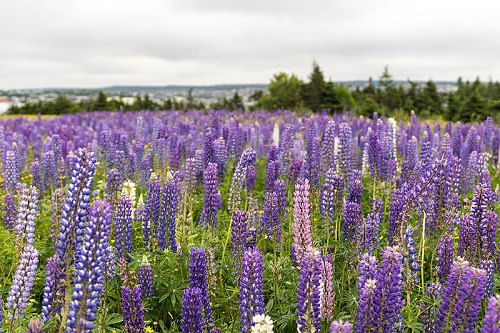
Lupines are beloved for their tall, spiky flower clusters that rise above bushy foliage, forming a dramatic vertical display. The purple varieties, often seen in wildflower meadows, blend beautifully with blues, whites, and pinks. These nitrogen-fixing plants enrich the soil and thrive in cooler climates with full sun exposure.
________________________________________
23. Lilac
Botanical Name: Syringa
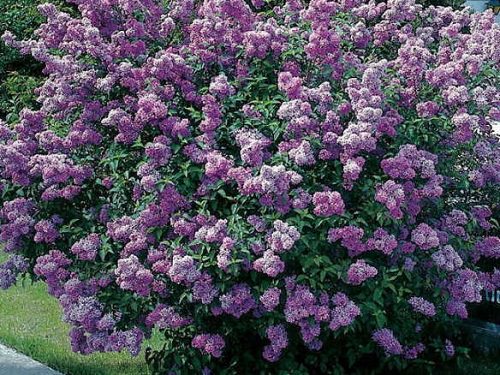
Lilacs are timeless flowering shrubs known for their sweet, nostalgic fragrance and full, clustered blooms. Their purple hues range from soft lavender to deep violet, and they bloom in late spring, signaling the start of warmer days. Ideal for borders or as standalone specimens, they attract butterflies and provide excellent cut flowers.
________________________________________
24. Blazing Stars
Botanical Name: Liatris
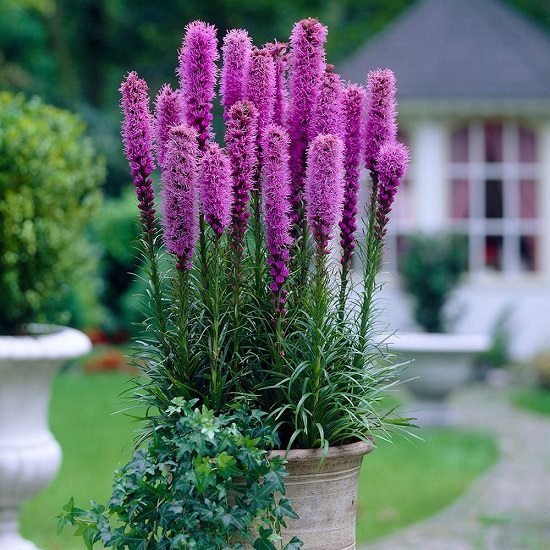
Also known as gayfeather, this native North American perennial features dense spikes of feathery purple flowers that bloom from the top down. The grass-like foliage forms a neat clump at the base. Liatris is drought-tolerant, low-maintenance, and a magnet for bees and butterflies, making it perfect for prairie or pollinator gardens.
________________________________________
25. Annual Honesty
Botanical Name: Lunaria annua
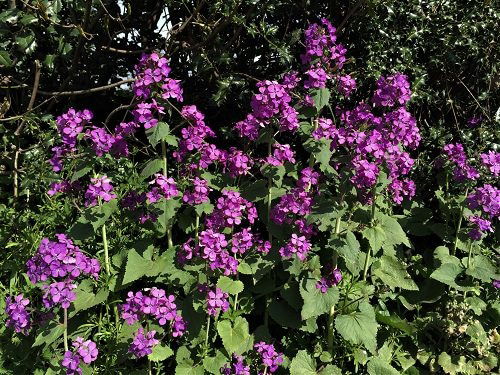
Recognized for its shimmering, translucent seedpods, Annual Honesty also produces fragrant purple blooms in spring. These biennials are appreciated for their rustic charm and are often found in cottage-style gardens. They self-seed easily, ensuring a continuous display year after year.
________________________________________
26. Heliotrope
Botanical Name: Heliotropium
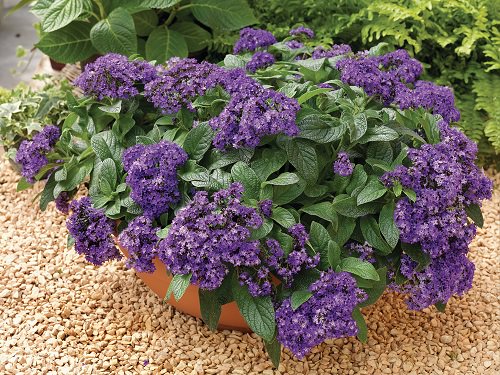
With clusters of small, richly scented flowers that carry a vanilla or cherry-pie fragrance, heliotropes are a sensory delight. The deep purple varieties are especially alluring and are best planted in containers or borders where their scent can be appreciated up close. They prefer full sun and well-drained soil.
________________________________________
27. Hardy Geranium
Botanical Name: Geranium bohemicum

This geranium species produces profuse, vivid purple-blue blooms that glow in partial shade. With deeply lobed leaves and a spreading habit, it makes an excellent groundcover. Unlike tender pelargoniums, hardy geraniums survive cold winters and return each spring, offering color and charm with minimal effort.
________________________________________
28. Geraldton Waxflower
Botanical Name: Chamelaucium uncinatum
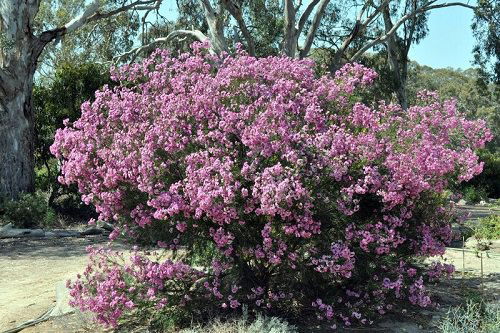
Native to Western Australia, this shrubby plant bears waxy, five-petaled purple or mauve flowers on long stems, making it a florist favorite. The fine, needle-like leaves give the plant a delicate, airy appearance. It thrives in full sun and well-drained soil, and blooms last a long time both in the garden and in vases.
________________________________________
29. Gladiolus
Botanical Name: Gladiolus

A staple of summer gardens and floral arrangements, gladiolus produces towering spikes of trumpet-shaped flowers in a rainbow of hues — including regal purples. Each flower spike is composed of multiple florets, blooming sequentially from bottom to top. Gladioli do best in full sun and are typically planted as corms.
________________________________________
30. Foxglove
Botanical Name: Digitalis
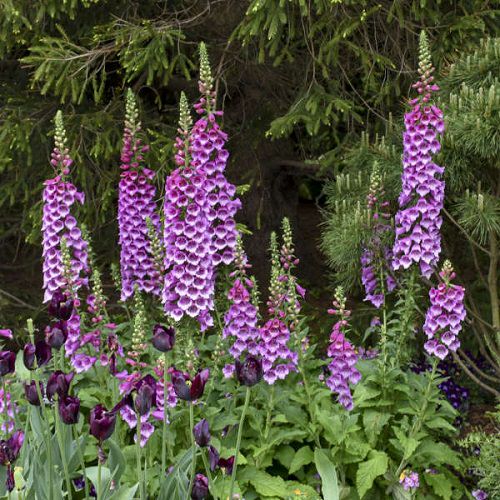
Known for their stately, tubular blooms arranged along tall stalks, foxgloves create a striking display in cottage or woodland gardens. Purple foxgloves are particularly captivating, often flecked with speckled throats that attract bees. These biennials are best placed toward the back of garden beds to allow their height to shine.
31. Dendrobium Orchid
Botanical Name: Dendrobium
Dendrobium orchids are among the most popular tropical orchids, cherished for their elegant blooms that range from white and pink to intense shades of purple. These orchids are epiphytic in nature, thriving in airy pots or mounted on bark. Purple dendrobiums stand out with their graceful, long-lasting blooms and make stunning indoor plants when given bright, indirect light and regular misting.
________________________________________
32. Columbine
Botanical Name: Aquilegia
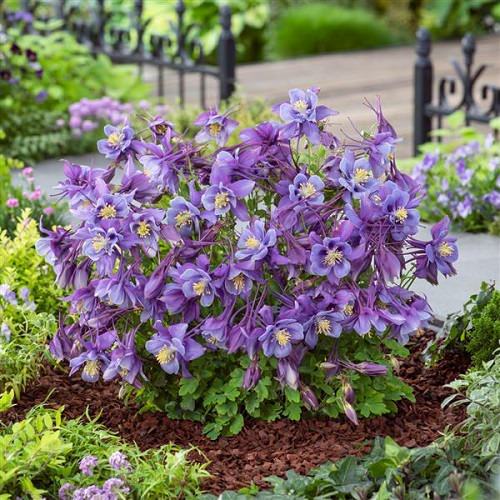
Columbines boast intricate, bell-like blossoms with long spurs that often nod gently in the breeze. Purple cultivars offer a unique, whimsical look and are highly attractive to hummingbirds and pollinators. These perennials naturalize easily and are ideal for woodland gardens or lightly shaded borders, where they add charm and movement.
________________________________________
33. Crocus
Botanical Name: Crocus
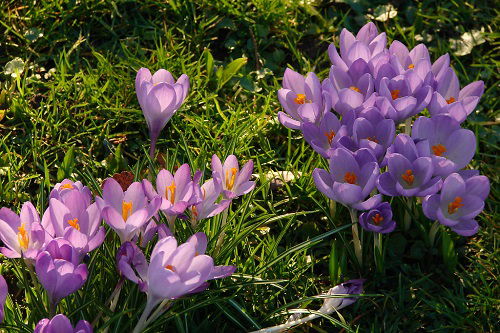
One of the first flowers to appear after winter, crocuses pop up through snow with cup-shaped blooms in hues of purple, violet, and gold. These hardy bulbs signal the arrival of spring and are beloved by bees awakening from dormancy. Plant them en masse for a carpet of color in rock gardens, lawns, or beneath deciduous trees.
________________________________________
34. Cyclamen
Botanical Name: Cyclamen
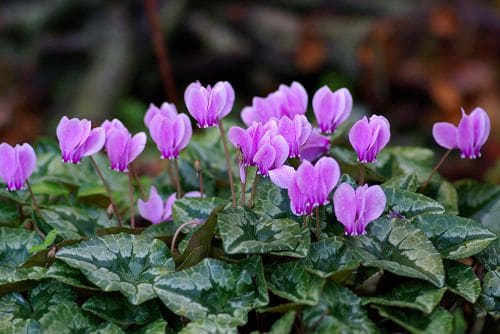
Cyclamen are prized for their attractive marbled leaves and upswept, reflexed petals. Purple varieties glow vibrantly, especially in winter or early spring when many other plants lie dormant. They perform best in cool, shady spots and are often used in container gardens, indoor displays, or beneath trees.
________________________________________
35. Candytuft
Botanical Name: Iberis
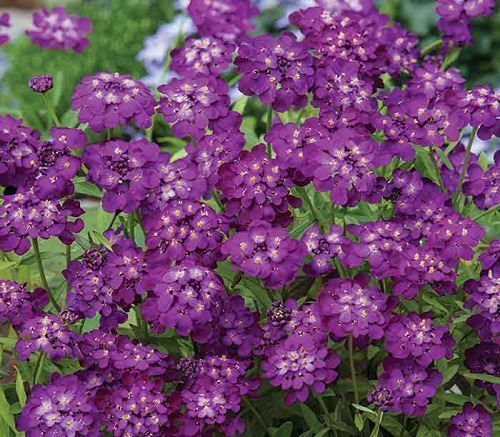
Although typically seen in white, some varieties of candytuft offer soft purple tones. This evergreen groundcover forms dense, low mats of foliage topped with clusters of small, cross-shaped blooms. It’s excellent for edging paths, spilling over walls, or filling in gaps in rock gardens.
________________________________________
36. Coneflower
Botanical Name: Echinacea
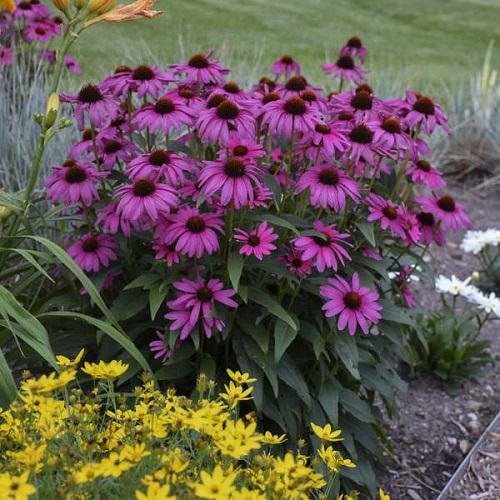
Echinacea is both a visual delight and a medicinal powerhouse. Its daisy-like blooms feature raised central cones surrounded by lavender or purple petals. Extremely pollinator-friendly, it thrives in poor soil, resists drought, and adds structure and long-lasting color to perennial borders. Birds love the seed heads, too.
________________________________________
37. Common Comfrey
Botanical Name: Symphytum officinale
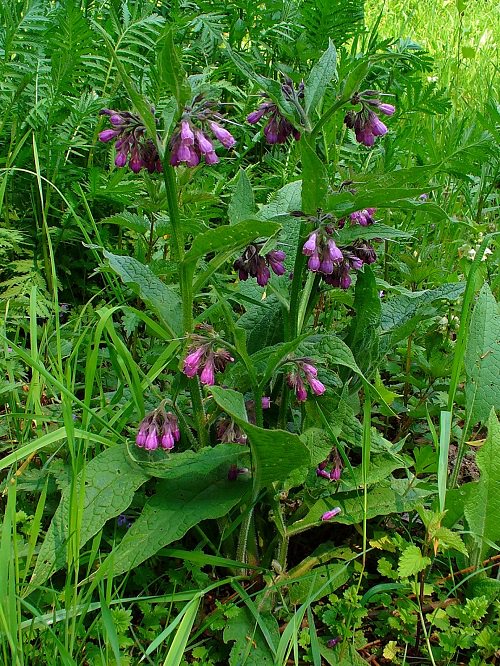
Comfrey’s bell-shaped purple flowers hang in drooping clusters from coarse, hairy stems. Though known more for its healing properties in herbal medicine, it’s also valued for its ability to attract pollinators and improve soil health. It’s ideal for permaculture gardens and naturalistic settings.
________________________________________
38. Garden Cosmos
Botanical Name: Cosmos bipinnatus
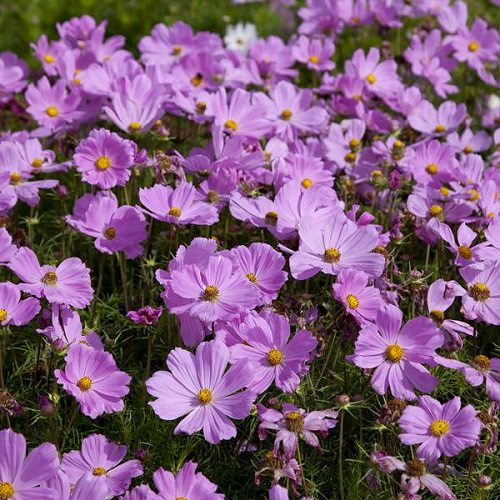
Cosmos is a cheerful annual that thrives with minimal care. Its feathery foliage and open, daisy-like flowers sway atop tall stems, and purple cultivars bring a soft romantic hue to wildflower patches or borders. These fast-growers are perfect for filling large sunny areas with continuous summer color.
________________________________________
39. Melastoma
Botanical Name: Melastoma
These tropical shrubs or small trees are distinguished by their striking, purple five-petaled flowers and fuzzy, textured leaves. Melastoma grows well in warm climates and performs beautifully in containers or garden beds. Their vibrant blooms draw pollinators and add lush vibrancy to tropical-themed plantings.
________________________________________
40. Cattleya Orchids
Botanical Name: Cattleya

Renowned as the “Queen of Orchids,” Cattleyas are known for their flamboyant, ruffled flowers, which come in vivid purples among other hues. Many have a delightful fragrance, and their large blooms make them favorites for corsages and wedding arrangements. They require filtered light, high humidity, and careful watering to thrive indoors.
41. Carnation
Botanical Name: Dianthus caryophyllus
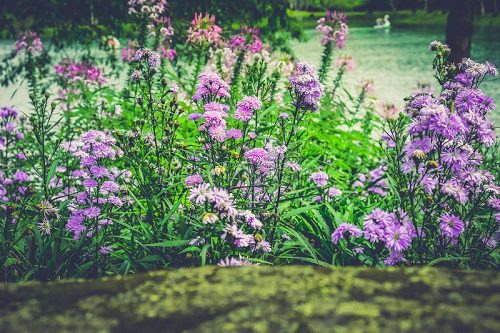
Carnations, affectionately called “Flowers of the Gods,” are cherished for their ruffled petals and long vase life. Purple carnations stand for capriciousness and unpredictability in the language of flowers, and they carry an unmistakable spicy fragrance. Whether used in floral arrangements or grown in the garden, they bring a touch of classic elegance.
________________________________________
42. Hollyhock
Botanical Name: Alcea
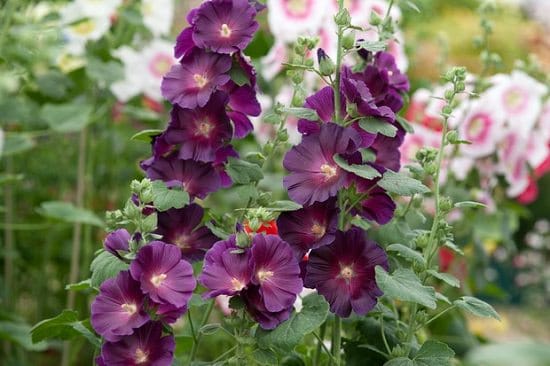
Towering hollyhocks can reach heights of up to 10 feet, making them ideal for the back of borders or cottage-style gardens. Their tall spires are lined with open-faced flowers, and the purple varieties create a majestic vertical statement. They bloom in succession from bottom to top and attract bees and hummingbirds alike.
________________________________________
43. Canterbury Bells
Botanical Name: Campanula medium
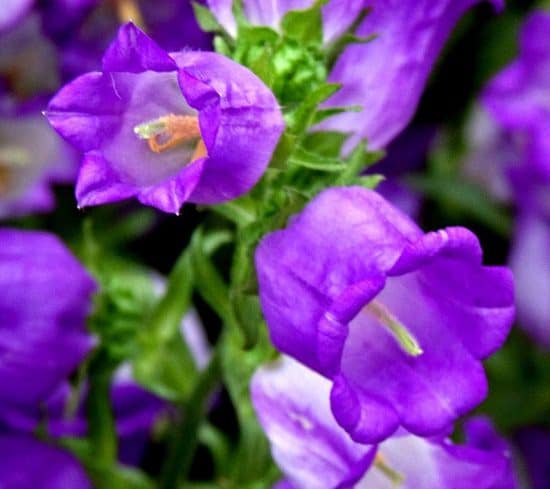
Canterbury Bells charm gardeners with their graceful, bell-shaped blooms in romantic shades of purple, lavender, and white. These biennials flower in late spring or early summer, standing tall with blooms that invite pollinators and add a fairytale feel to any landscape. Perfect for borders, bouquets, or mixed flowerbeds.
________________________________________
44. China Aster
Botanical Name: Callistephus chinensis
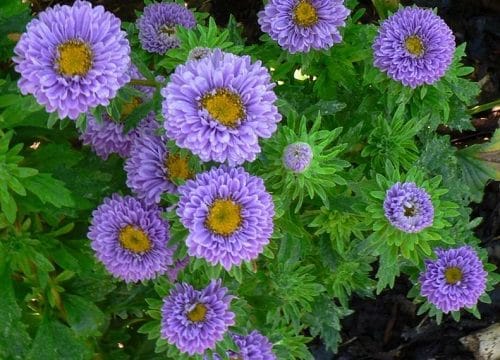
These late-summer bloomers display large, chrysanthemum-like flowers in a wide range of hues, with purple being particularly rich. Their dense, layered petals create a plush texture that holds well in arrangements. China asters grow well in containers or beds and offer a reliable splash of color as the season winds down.
________________________________________
45. Camas Lily
Botanical Name: Camassia
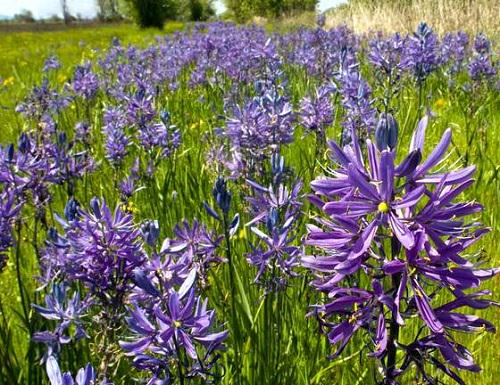
Camas lilies grace spring meadows with starry blooms in soft blue to deep purple. Native to North America, they were historically valued by Indigenous peoples for their edible bulbs. These bulbs thrive in moist, rich soil and look stunning when naturalized in groups in wildflower gardens or beside water features.
________________________________________
46. Blue-Eyed Grass
Botanical Name: Sisyrinchium
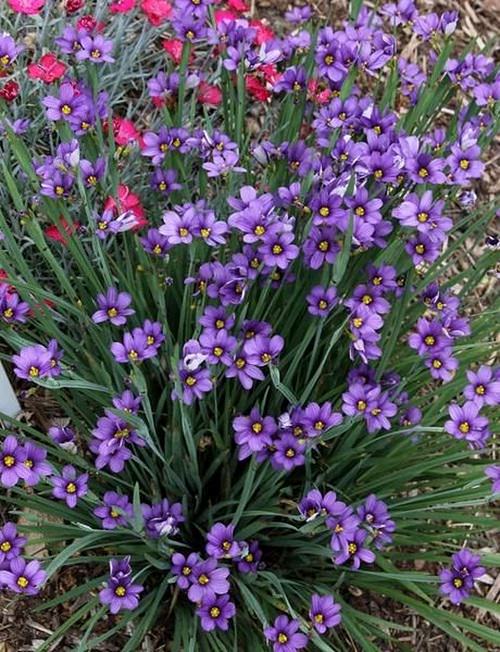
Despite its name, this plant is not a true grass. It belongs to the iris family and sports fine, grass-like foliage with dainty, star-shaped purple blooms that open in sunlight. It’s perfect for borders and rock gardens, providing a subtle yet graceful touch to informal plantings.
________________________________________
47. Blue False Indigo
Botanical Name: Baptisia australis
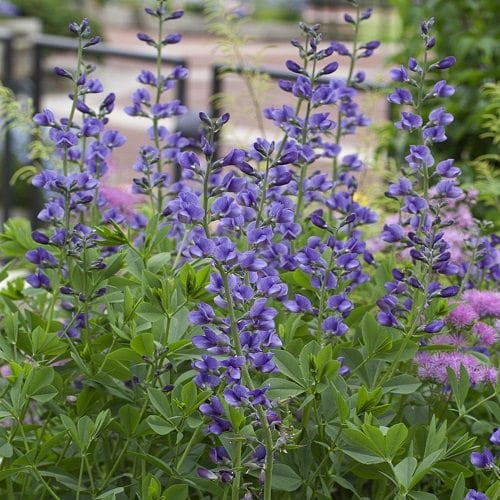
This robust perennial showcases spires of pea-like purple-blue flowers in late spring. Its deep roots make it drought-tolerant and long-lived. The foliage forms a tidy bush that stays attractive even after flowering, making it a fantastic low-maintenance choice for borders or prairie-style gardens.
________________________________________
48. Bee Orchid
Botanical Name: Ophrys apifera
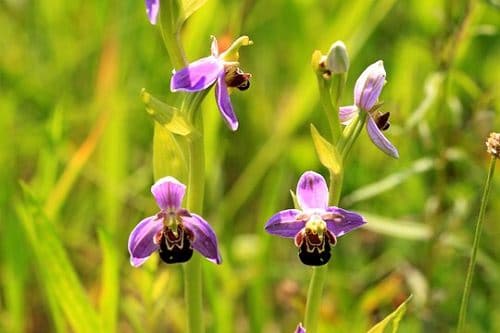
This orchid is a marvel of mimicry, with flowers that imitate the appearance of a female bee, attracting male bees to aid in pollination. The petals are often tinged in purples and pinks, giving the bloom a whimsical charm. It grows best in poor, chalky soils and is a prized find in wildflower-rich meadows.
________________________________________
49. Anemone
Botanical Name: Anemone coronaria

These bold, poppy-like flowers feature contrasting centers and wide, silky petals. Purple anemones are particularly eye-catching and bloom in spring or fall, depending on the variety. They work beautifully in both garden beds and vases, adding drama and color with their upright, elegant form.
________________________________________
50. Lily of the Nile
Botanical Name: Agapanthus
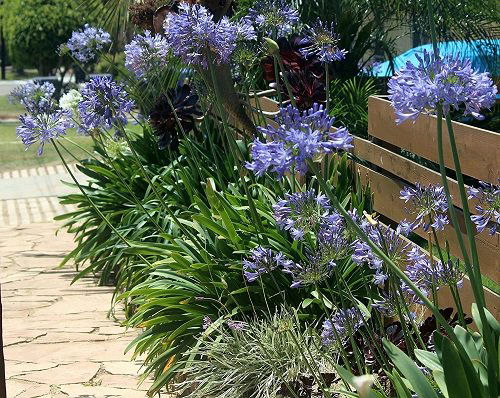
Agapanthus produces globe-shaped flower heads on tall, slender stems, with shades ranging from pale lavender to deep royal purple. Native to South Africa, these sun-loving perennials thrive in containers or along borders. Their strap-like leaves form a neat base, while the airy blooms sway gracefully in the breeze.
51. Hummelo
Botanical Name: Stachys monieri ‘Hummelo’

‘Hummelo’ is a standout cultivar of betony, known for its upright spikes of clustered purple-pink flowers that bloom in mid to late summer. It forms a tidy mound of scalloped green foliage and is incredibly reliable in sunny borders. Loved by pollinators, this deer-resistant perennial adds structure and texture to mixed plantings.
________________________________________
52. Wolf’s Bane
Botanical Name: Aconitum
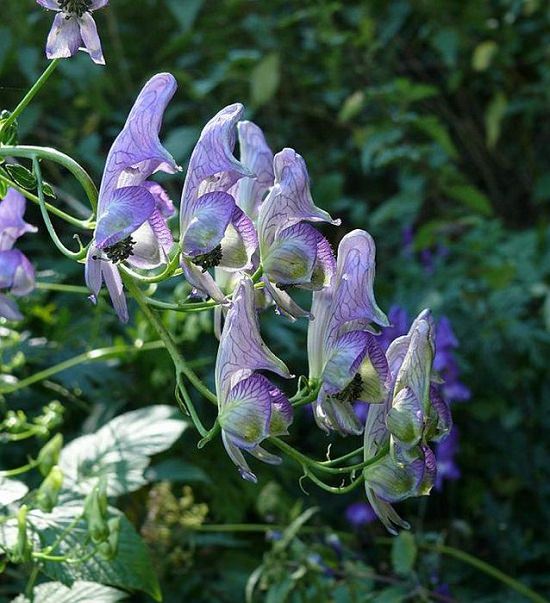
Also called monkshood due to the hood-like shape of its upper petals, wolf’s bane is both alluring and mysterious. Its deep purple spires rise dramatically from dark green foliage. While incredibly beautiful, it’s also highly toxic — a true garden beauty with a dangerous side. It thrives in cool, moist conditions and partial shade.
________________________________________
53. Ornamental Allium
Botanical Name: Allium ‘Purple Sensation’
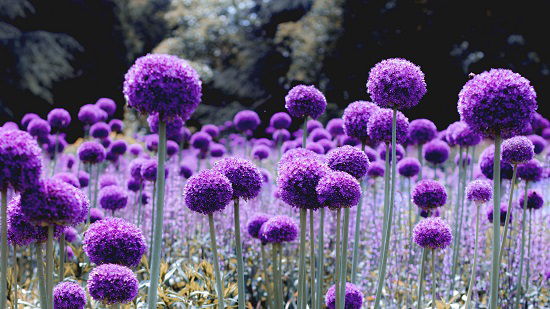
These globe-shaped blooms resemble fireworks frozen in time. ‘Purple Sensation’ stands out with its compact, vibrant violet spheres held atop sturdy stalks. A member of the onion family, ornamental allium is deer-resistant and excellent for cutting gardens. It blooms in late spring and adds drama and symmetry to garden beds.
________________________________________
54. Salvia
Botanical Name: Salvia spp.
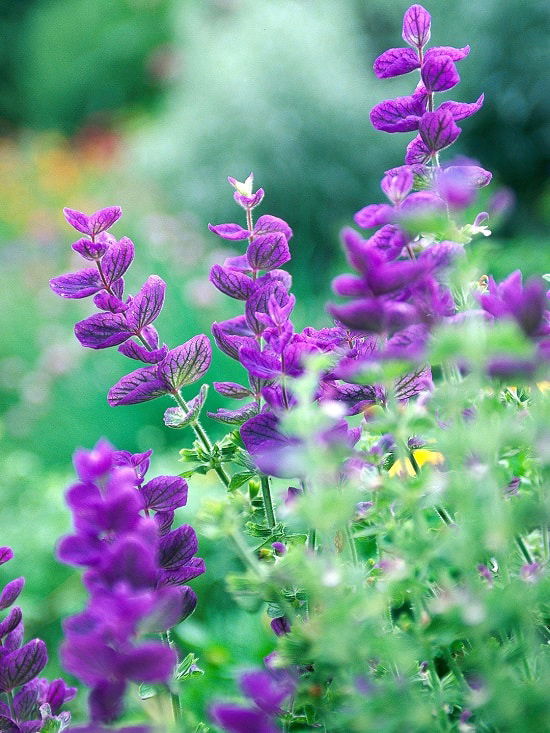
Salvias are sun-loving, long-blooming plants with spiky flowers in shades from deep indigo to bright violet. Purple varieties like ‘Caradonna’ or ‘Amistad’ attract hummingbirds, bees, and butterflies. These aromatic perennials are low-maintenance, drought-tolerant, and ideal for both herbaceous borders and pollinator gardens.
________________________________________
55. Catmint
Botanical Name: Nepeta
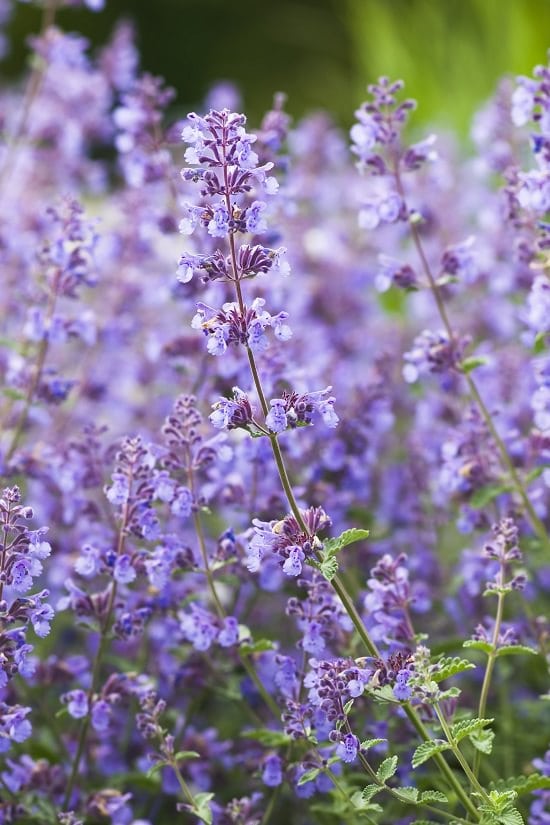
Catmint is a hardy perennial that bursts into clouds of soft purple-blue flowers throughout the summer. It has fragrant gray-green foliage and a graceful, mounding habit. Catmint is perfect for edging walkways or mixing into cottage gardens and is often visited by bees and butterflies. It thrives in full sun and tolerates dry conditions.
________________________________________
56. Balloon Flower
Botanical Name: Platycodon grandiflorus
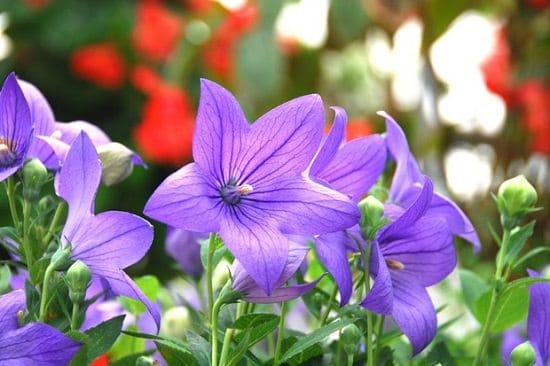
Balloon flowers get their whimsical name from the puffed, balloon-like buds that pop open into star-shaped blooms. The purple varieties are especially striking against the plant’s dark green foliage. Compact and easy to grow, they’re a charming choice for borders, containers, or rock gardens.
________________________________________
57. Iris Pumila
Botanical Name: Iris pumila

This dwarf bearded iris produces dramatic, richly colored blooms in spring. Purple cultivars are especially eye-catching, with velvety petals that stand out against sword-like leaves. Iris pumila is ideal for rock gardens, borders, or the front of perennial beds. It thrives in full sun and well-drained soil.
________________________________________
58. Bell Flowers
Botanical Name: Campanula
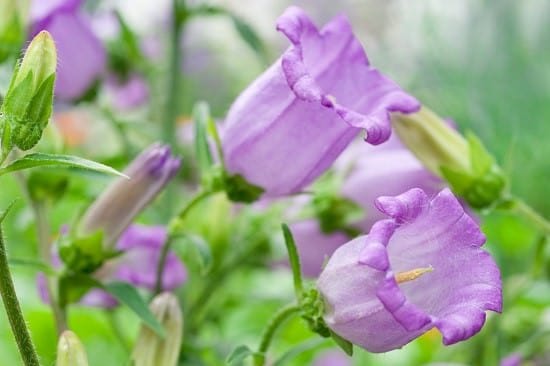
With their iconic bell-shaped blooms, Campanula species come in various forms, from low-growing ground covers to upright varieties. Purple bellflowers add a whimsical, romantic touch and are known for their resilience and long blooming season. Ideal for borders, containers, and wildflower meadows alike.
________________________________________
59. Leather Flower
Botanical Name: Clematis
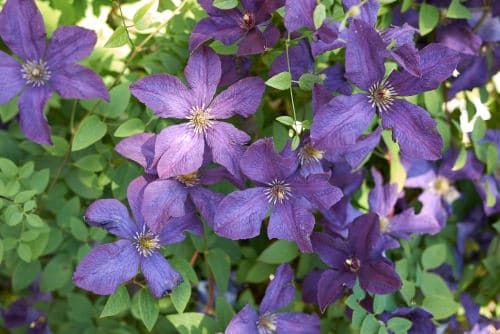
A type of clematis, leather flowers boast urn-shaped blooms in shades of rich purple. Their name comes from their leathery-textured foliage rather than the flowers themselves. These climbing vines are perfect for fences, trellises, or pergolas, and they add elegance and vertical interest to any garden space.
________________________________________
60. Lavender
Botanical Name: Lavandula
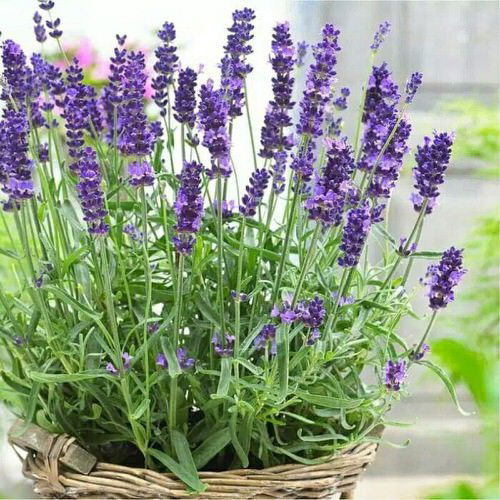
Lavender is a classic Mediterranean herb known for its calming fragrance and silvery foliage. The purple spikes of small flowers not only perfume the air but also attract bees and butterflies. Hardy and drought-tolerant, lavender thrives in full sun and well-drained soil, and is beautiful in borders, herb gardens, or even as a low hedge.
61. Lily of the Incas
Botanical Name: Alstroemeria
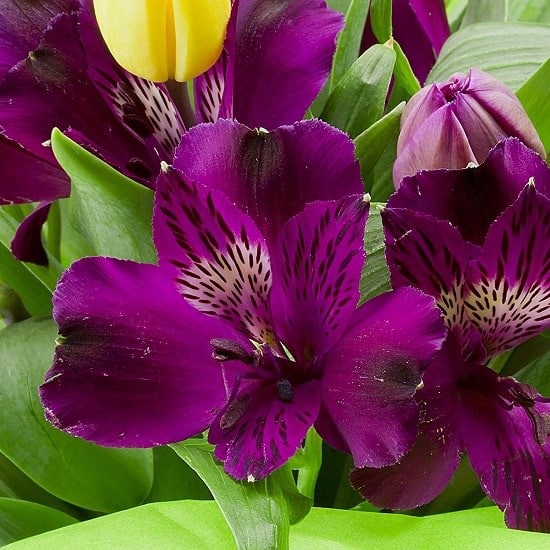
Also called Peruvian Lily or Parrot Lily, this exquisite flower symbolizes friendship and devotion. Its trumpet-shaped blooms are freckled and striped, with many cultivars featuring rich purple tones. Alstroemeria is prized in floral arrangements for its longevity and exotic appearance. In the garden, it thrives in sun or partial shade and blooms abundantly through summer.
________________________________________
63. Bell Heather
Botanical Name: Erica cinerea
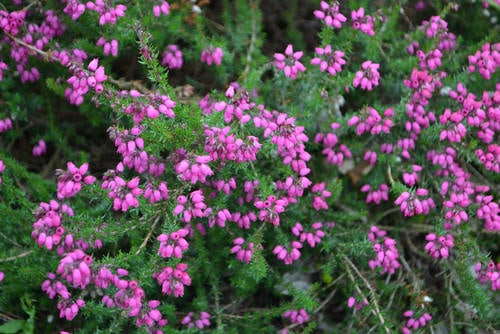
Often referred to as Velvet Night for its deeply colored blooms, Bell Heather is a low-growing, evergreen shrub covered in dense spikes of bell-shaped purple flowers. Blooming from late spring through fall, it’s perfect for rock gardens, heaths, and containers. It thrives in acidic soil and attracts pollinators to its vivid display.
________________________________________
64. Yesterday, Today, and Tomorrow
Botanical Name: Brunfelsia pauciflora
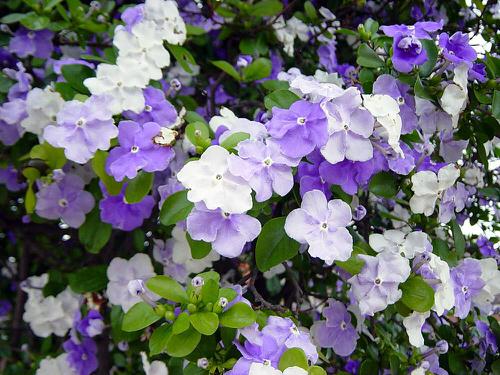
This captivating shrub gets its name from the way its flowers change color — deep purple on the first day, fading to lavender and then white. Though visually stunning, the plant belongs to the nightshade family and contains toxic components. It prefers a warm, humid environment with partial shade, and its fragrant blooms are a highlight of tropical gardens.
________________________________________
66. Hyacinth
Botanical Name: Hyacinthus orientalis
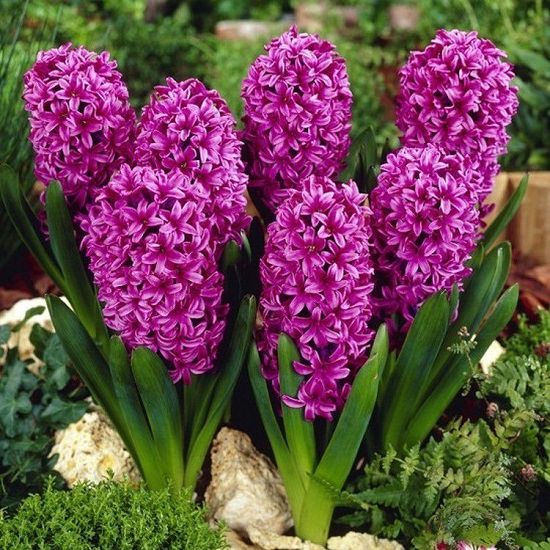
Hyacinths herald spring with their dense, fragrant flower spikes in jewel tones including violet and deep purple. These bulbous perennials are beloved for their intoxicating scent and bold appearance. Plant them in beds, containers, or along walkways where their perfume can be fully appreciated. They thrive in sunny spots with well-drained soil.
________________________________________
67. Evening Primroses
Botanical Name: Onagraceae
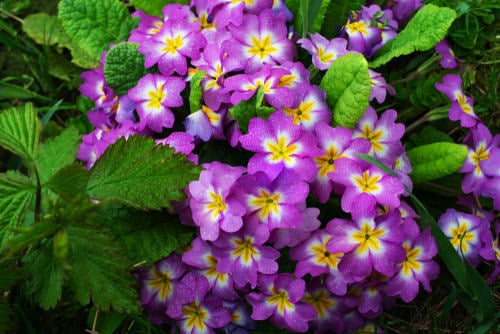
Though often associated with yellow, some cultivars of Evening Primrose display charming purple tones. Their goblet-shaped flowers open in the evening, releasing a subtle scent and attracting moths and night pollinators. The plant also produces omega-6-rich seeds and is known for its medicinal properties. Perfect for wildflower gardens or naturalized spaces.
________________________________________
68. Bougainvillea
Botanical Name: Bougainvillea glabra
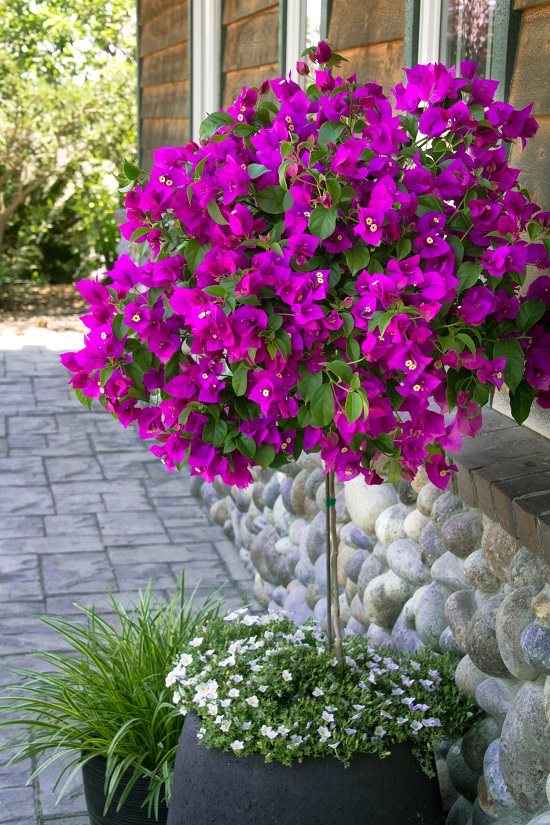
Bougainvillea is a vigorous climber that thrives in warm climates, cloaking fences, walls, and trellises in cascades of papery purple bracts that surround its tiny true flowers. Drought-tolerant and sun-loving, it adds vibrant color to patios and balconies. While often pruned into compact forms, it can also sprawl beautifully when left to grow freely.
________________________________________
69. Bellflower
Botanical Name: Campanula
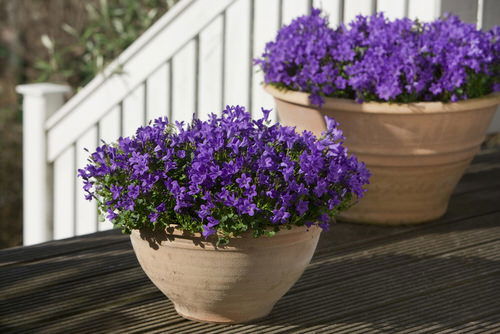
Campanula makes another appearance with this charming species of bell-shaped flowers, predominantly in purple hues. Whether used as a groundcover or a flowering accent in containers and hanging baskets, this bellflower is resilient and blooms generously through spring and summer, lighting up shady corners and garden edges.
________________________________________
70. Bittersweet Nightshade
Botanical Name: Solanum dulcamara
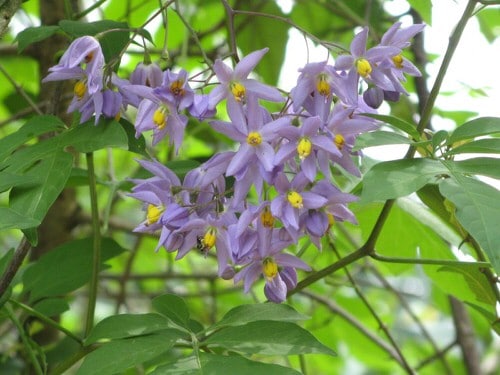
This twining vine produces star-shaped purple flowers with yellow stamens, followed by bright red berries. While visually appealing, it should be grown with care as the berries are toxic if ingested. Bittersweet Nightshade is useful as a fast-growing climber for trellises or fences, where it can form a dense, flowering screen.
71. Dendrobium Orchid (Revisited)
Botanical Name: Dendrobium
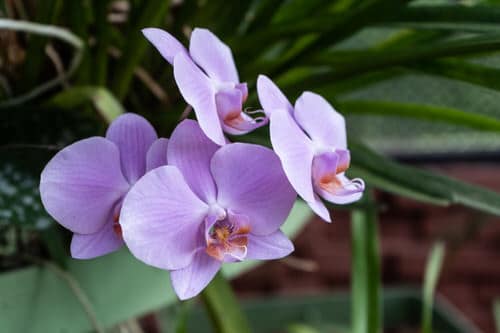
Making another appearance, Dendrobium orchids are a must-have for orchid lovers. Their shallow root systems make them perfect for window boxes and small containers. The striking purple blooms last for weeks and bloom in a tiered formation along slender stems. They do best in filtered light with consistent moisture and good air circulation.
________________________________________
72. Lungwort
Botanical Name: Pulmonaria officinalis
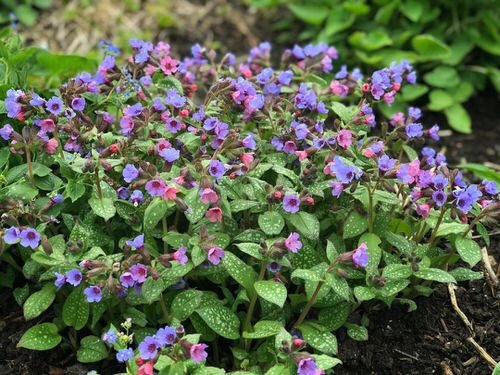
Lungwort is easily recognized by its spotted, silvery leaves and clusters of funnel-shaped flowers that can bloom in shades of pink, blue, and especially violet to purple. A beloved shade perennial, it’s often planted under trees or alongside early bulbs. Its common name comes from the belief that the foliage resembled diseased lungs and had medicinal use in treating respiratory ailments.
________________________________________
79. Cheeses
Botanical Name: Malva sylvestris
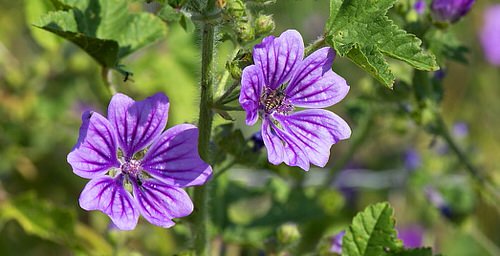
Also known as common mallow, this wildflower produces generous purple blooms with distinctive dark veining. Hardy and easy to grow, it’s often seen along roadsides or in cottage gardens. The plant has traditional herbal uses, and its showy flowers attract bees, butterflies, and other pollinators throughout the summer months.
________________________________________
80. Purple Pansy
Botanical Name: Viola tricolor
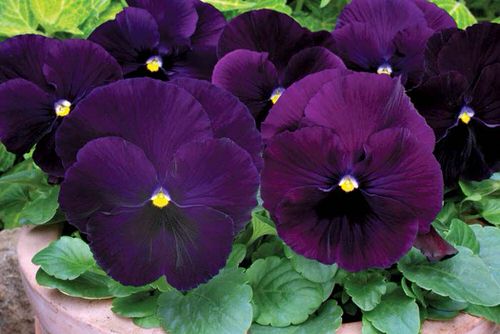
Pansies in shades of purple are among the most versatile cool-season flowers. Their charming “faces” brighten containers, borders, and even indoor pots. They’re low-growing, cold-hardy, and bloom prolifically in spring and fall. Purple pansies pair well with taller companions and are often used to underplant trees or shrubs.
________________________________________
81. Scabiosa
Botanical Name: Scabiosa

Delicate yet durable, Scabiosa — also known as the pincushion flower — features soft purple blooms that rise on slender stems. These perennials are disease-resistant, butterfly-friendly, and ideal for rock gardens, borders, or small containers. They bloom from late spring to fall and are a favorite in cut flower arrangements.
________________________________________
82. Sweet Rocket
Botanical Name: Hesperis matronalis
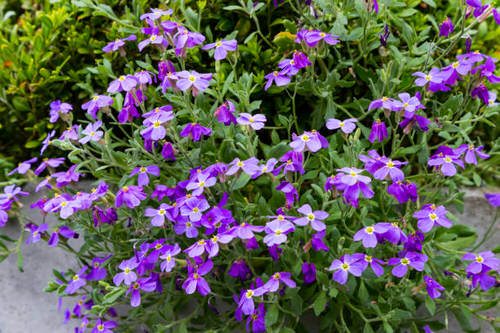
Sweet Rocket is a biennial that produces tall, branching stems filled with fragrant, four-petaled purple or white flowers. Best enjoyed in the evening when its scent intensifies, it’s perfect for naturalistic gardens and pairs beautifully with other cottage garden staples. Once established, it often self-seeds, returning each year without much fuss.



